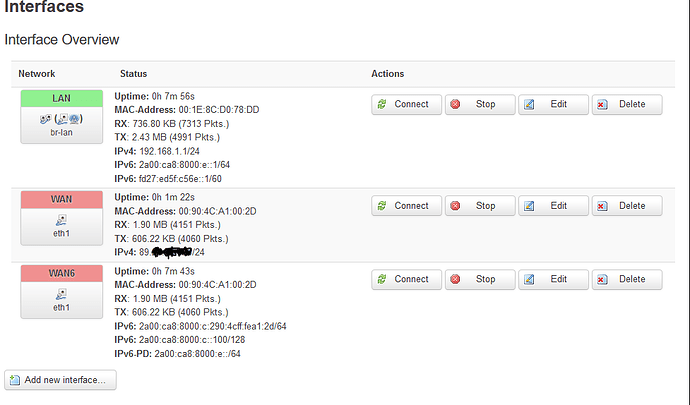OK i tried another router with brand new LEDE install - same behaviour as with turris.
Current status:
directly on router IPv6 works as expected
client get IPv6 address but unable to reach any IP
root@LEDE:~# ip addr sh
1: lo: <LOOPBACK,UP,LOWER_UP> mtu 65536 qdisc noqueue state UNKNOWN qlen 1
link/loopback 00:00:00:00:00:00 brd 00:00:00:00:00:00
inet 127.0.0.1/8 scope host lo
valid_lft forever preferred_lft forever
inet6 ::1/128 scope host
valid_lft forever preferred_lft forever
2: eth0: <BROADCAST,MULTICAST,UP,LOWER_UP> mtu 1500 qdisc fq_codel master br-lan state UP qlen 1000
link/ether 00:1e:8c:d0:78:dd brd ff:ff:ff:ff:ff:ff
3: eth1: <BROADCAST,MULTICAST,UP,LOWER_UP> mtu 1500 qdisc fq_codel state UP qlen 1000
link/ether 00:90:4c:a1:00:2d brd ff:ff:ff:ff:ff:ff
inet 89.xx.xx.xx/24 brd 89.xx.xx.255 scope global eth1
valid_lft forever preferred_lft forever
inet6 2a00:ca8:8000:c:290:4cff:fea1:2d/64 scope global dynamic
valid_lft 86389sec preferred_lft 14389sec
inet6 2a00:ca8:8000:c::100/128 scope global dynamic
valid_lft 15616sec preferred_lft 14016sec
inet6 fe80::290:4cff:fea1:2d/64 scope link
valid_lft forever preferred_lft forever
5: br-lan: <BROADCAST,MULTICAST,UP,LOWER_UP> mtu 1500 qdisc noqueue state UP qlen 1000
link/ether 00:1e:8c:d0:78:dd brd ff:ff:ff:ff:ff:ff
inet 192.168.1.1/24 brd 192.168.1.255 scope global br-lan
valid_lft forever preferred_lft forever
inet6 2a00:ca8:8000:e::1/64 scope global dynamic
valid_lft 15616sec preferred_lft 14016sec
inet6 fd27:ed5f:c56e::1/60 scope global
valid_lft forever preferred_lft forever
inet6 fe80::21e:8cff:fed0:78dd/64 scope link
valid_lft forever preferred_lft forever
6: wlan0: <BROADCAST,MULTICAST,UP,LOWER_UP> mtu 1500 qdisc mq master br-lan state UP qlen 1000
link/ether 00:1e:8c:d0:78:dd brd ff:ff:ff:ff:ff:ff
inet6 fe80::21e:8cff:fed0:78dd/64 scope link
valid_lft forever preferred_lft forever
root@LEDE:~#
root@LEDE:~# ip -6 route sh
default from 2a00:ca8:8000:c::100 via fe80::225:90ff:fea9:ec16 dev eth1 metric 384
default from 2a00:ca8:8000:c::/64 via fe80::225:90ff:fea9:ec16 dev eth1 metric 384
default from 2a00:ca8:8000:e::/64 via fe80::225:90ff:fea9:ec16 dev eth1 metric 384
2a00:ca8:8000:c::/64 dev eth1 metric 256
2a00:ca8:8000:e::/64 dev br-lan metric 1024
unreachable 2a00:ca8:8000:e::/64 dev lo metric 2147483647 error -148
fd27:ed5f:c56e::/64 dev br-lan metric 1024
unreachable fd27:ed5f:c56e::/48 dev lo metric 2147483647 error -148
fe80::/64 dev eth1 metric 256
fe80::/64 dev br-lan metric 256
fe80::/64 dev wlan0 metric 256
unreachable default dev lo metric -1 error -128
ff00::/8 dev br-lan metric 256
ff00::/8 dev eth1 metric 256
ff00::/8 dev wlan0 metric 256
unreachable default dev lo metric -1 error -128
Wireless LAN adapter Wi-Fi:
Connection-specific DNS Suffix . : lan
Description . . . . . . . . . . . : Dell Wireless 1820 802.11ac
Physical Address. . . . . . . . . : 90-CD-B6-1D-20-21
DHCP Enabled. . . . . . . . . . . : Yes
Autoconfiguration Enabled . . . . : Yes
IPv6 Address. . . . . . . . . . . : 2a00:ca8:8000:e:bd31:c783:df3a:b880(Preferred)
IPv6 Address. . . . . . . . . . . : fd27:ed5f:c56e:0:bd31:c783:df3a:b880(Preferred)
Temporary IPv6 Address. . . . . . : 2a00:ca8:8000:e:e890:2296:7742:fa8f(Preferred)
Temporary IPv6 Address. . . . . . : fd27:ed5f:c56e:0:e890:2296:7742:fa8f(Preferred)
Link-local IPv6 Address . . . . . : fe80::bd31:c783:df3a:b880%25(Preferred)
IPv4 Address. . . . . . . . . . . : 192.168.1.219(Preferred)
Subnet Mask . . . . . . . . . . . : 255.255.255.0
Lease Obtained. . . . . . . . . . : Tuesday, March 7, 2017 11:10:10 AM
Lease Expires . . . . . . . . . . : Tuesday, March 7, 2017 11:10:10 PM
Default Gateway . . . . . . . . . : fe80::21e:8cff:fed0:78dd%25
192.168.1.1
DHCP Server . . . . . . . . . . . : 192.168.1.1
DHCPv6 IAID . . . . . . . . . . . : 294702518
DHCPv6 Client DUID. . . . . . . . : 00-01-00-01-1F-CF-34-59-F8-CA-B8-54-55-2B
DNS Servers . . . . . . . . . . . : 192.168.1.1
NetBIOS over Tcpip. . . . . . . . : Enabled
On client
ping www.root.cz -6
Pinging root.cz [2001:67c:68::76] with 32 bytes of data:
Request timed out.
Request timed out.
Request timed out.
ping fe80::21e:8cff:fed0:78dd%25
Pinging fe80::21e:8cff:fed0:78dd%25 with 32 bytes of data:
Reply from fe80::21e:8cff:fed0:78dd%25: time=2ms
Reply from fe80::21e:8cff:fed0:78dd%25: time=5ms
Reply from fe80::21e:8cff:fed0:78dd%25: time=3ms
Reply from fe80::21e:8cff:fed0:78dd%25: time=2ms
Ping statistics for fe80::21e:8cff:fed0:78dd%25:
Packets: Sent = 4, Received = 4, Lost = 0 (0% loss),
Approximate round trip times in milli-seconds:
Minimum = 2ms, Maximum = 5ms, Average = 3ms



